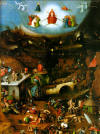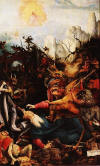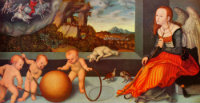Search:: Artists Alphabetically Artists by Country Artists by Century Artists by Movement
Northern Renaissance Art History, Regions, Style and Characteristics
The Northern Renaissance was a time of great intellectual and spiritual awakening. French, German and Netherlandish painters took leadership in the development of a new style of painting while retaining strong Gothic elements within their art-work. The political and religious situation of the region had a profound influence on painters. The ensuing chaos and upheaval of the church meant that there was no single artistic nucleus. According to art historian Carleton Noyes "The special work is the momentary epitome of the artist's total meaning. He finds this brief passage in nature beautiful then and there because it expresses what he feels and means. He does not try to reproduce the thing, but uses the thing for what it signifies. The thing is but for that moment: it signifies all that has gone before. As he watches, a cloud passes over the sun and the face of nature is darkened. Suddenly the scene bursts into light again. In itself the landscape is no brighter than before the sun was darkened. The painter feels it brighter for the contrast, and inevitably his rendering of its aspect is heightened and intensified."
Thus there were a number of places where influential art was being created, with regional variations in technique and style.
Important Northern Renaissance Artists
Pieter Brueghel the Younger (1564 - 1638) Flemish
Lucas Cranach the Elder (1472 - 1553) German
Matthias Grünewald (1434-1494) Flemish
Hans Holbein the Younger (1497-1543) German
Rogier van der Weyden (1399-1464) Dutch
Jan van Eyck (1385 - 1441) Flemish
Robert Campin 1375-1444 Dutch
Hans Melming 1434-1494 German
Petrus Christus (1420–1476) Netherlandish
Jan Provoost (1465–1529) Flemish School, Netherlandish
Hugo Van Der Goes (1430-1482)
Joos van Cleve (1485 – 1540) Netherlandish
Joachim Patinir (1480 –1524) Flemish School
Michael Wolgemut (1434–1519) German
Michael Pacher (1435– 1498) Austrian
Colijn de Coter (1445–1532) Netherlandish
Gerard Horenbout (1465 - 1541) Flemish School,
Jean Malouel (1365-1415) French Early Netherlandish
Hieronymus Bosch (1453 - 1516) Dutch
Dieric Bouts the Elder (1413-1475) Dutch
Through trade and innovtion Northern Europe became increasingly prosperous. Professor A. J. Wauters asserts "It was the immediate result of a great development in the prosperity, wealth, and intellect of the country. Christian Art now shone forth, realistic and true to nature in its outer forms, though still mystical and austere in spirit. Faith still existed, and the primitive devotion was as deep as ever, but the general spirit was altered : the picturesque age had succeeded the symbolic. Artists had become interested in nature : they studied anatomy, landscape, perspective, architecture, accessories ; their works glorified the actual life of the present as well as the life to come. Their pictures, which were chiefly intended for altars and oratories, represented none but religious subjects, yet they told of the pomp, the elegance, the unparalleled magnificence of the time of the Dukes of Burgundy. This was the epoch of the great Jean Van Eyck, of his brother Hubert, of Van der Weyden, Van der Goes, Cristus, Bouts, Memling, Gheerardt David, Jerome Bosch, and of Quentin Metsys."
One of the major difference between Italian Renaissance and Northern Renaissance is that Northern painters rejected decadent Greek and Roman influences, focusing more on domestic scenes, satire, and philosophical themes. Humanism was emerging, and religious devotion, though still an important part of people's lives, was being restructured to accommodate the belief that man can be master his own fate. Carleton Noyes asserts "The material world which we see and touch is but the symbol and bodying forth of spiritual relations. The tranquillizing, satisfying power of art is due to the revelation which art accomplishes of a spiritual harmony which transcends the seeming chaos of instant experience. So it comes about that harmony, or beauty, which is of the spirit, is apprehended by the spirit. That faculty in the artist by which he is able to perceive beauty is called temperament. By temperament is to be understood the receptive faculty, the power to feel, the capacity for sensations, emotions, and "such intellectual apprehensions as, in strength and directness and their immediately realized values at the bar of an actual experience, are most like sensations." The function of temperament is to receive and to transmit, to interpret, to create in the sense that it reveals. In the result it is felt to be present only as the medium through which the forces behind it come to expression."

Important Words, People, Phrases, Characteristics related to the Northern Renaissance Art Movement - allegorical painting, rebirth, invention of oil painting, Hieronymus Bosch, Limbourg Brothers, Desiderius Erasmus, Robert Campin, Jan Van Eyck, Jean Fouquet, Albrecht Dürer, Johannes Gutenberg, Johann Reuchlin, Martin Luther, rise of the merchant class, world landscape, Low Countries, Protestant Reformation, Calvinisim, glazing, impasto, scriptorium, illuminator, invention of the printing press, woodcuts, engravings, Antwerp School, Guild of Saint Luke, commerce, Flemish School, Northern Europe, Flanders, Bruges, renewed interest in classical learning, mythological scenes, genre painting, landscapes, portraits, moralizing overtones, human vices, lust, paradise, spirituality, piousness, living a simple life, reform, Human Reasoning, tradesmen at work, idyllic scenes of peasants, playing games, feasting, linear perspective, \Heliocentric Theory, humour, satire, spiritually significant, illuminated manuscript, idealized biblical themes, scriptorium, emotion, illuminator, iconoclast, Age of Discovery, Virgin and Child, axonometric drawing, curiosity about the natural world, realistic use of colours and light, Old Testament stories, Gospel parables, The Blackdeath, Christian symbolism
If
you feel you have worthwhile information you would like to contribute
we would love to hear from you. We collect essential biographical
information and artist quotes from folks all over the globe and
appreciate your participation. When submitting please, if possible,
site the source and provide English translation. Please
submit your comment to the editor, via e-mail and if possible site the
source. Thank you!
© HistoryofPainters.com
If you like this page and wish to share it, you
are welcome to link to it, with our thanks.
copyright 2017 - historyofpainters.com



